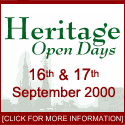-
Built
for the merchant guild of St Mary in 1342, three years before
Coventry received its royal Charter of Incorporation as a town.
-
Part
of the building adjoins the bakehouse of an earlier Coventry
Castle, built for the Earls of Chester in 1139.
-
In
1388 an angry mob burst in and threw loaves of bread at the Mayor
because he had not enforced laws governing the quality of bread.
-
The
handle of Coventry's ceremonial sword, stolen from St Mary's Hall
in 1481, turned up on a rubbish heap in London 400 years later and
is now in the Burrell Collection in Glasgow.
-
The
Coventry Tapestry on the hall's north wall depicts Henry VI and
Margaret of Anjou and was in place for the visit of Henry VII in
1499. Almost uniquely, it still hangs in the place for which it
was designed.
-
The
gallery of kings in the 15th century window above the tapestry
includes a rare representation of King Arthur.
-
After
rioting in the hall in 1525, five ringleaders had their ears
nailed to the pillory.
-
Tradition
has it that a table in the hall's Old Council Chamber was the
table on which Lord Lucy of Charlecote signed the arrest warrant
for William Shakespeare on deer poaching charges.
-
In
1603, the young Princess Elizabeth, eldest daughter of James I,
was dined in the hall and given a silver cup which was 27 inches
high and too heavy for her to lift.
-
During
a banquet for James II in 1687, a hapless guest leaned on an
over-loaded table, causing it to collapse and showering the royal
party with food, including Coventry Custard.
-
The
biggest banquet ever held in the hall took place in 1755 for the
inauguration of John Hewitt as mayor. Nearly 800 people attended
and put away a menu that included 18 fat roasted pigs, 30 turkeys
and 20 dozen bottles of port. And that was just the first course.
-
In
the 1750s soldiers were billeted in St Mary's Hall to guard the
city's jail, believed to be under threat from the 200-strong
Coventry Gang, determined to free members incarcerated inside.
-
For
much of the 18th century St Mary's Hall was used extensively as a
theatre. The great actress Sarah Siddons, married in nearby Holy
Trinity Church in 1773, performed there several times.
-
Heavy
rain forced the preacher John Wesley to request the use of the
hall during a visit to Coventry in 1779. The mayor turned him down
in favour of a dancing master.
-
The
following year, pitched battles during a violent election campaign
cost St Mary's Hall most of its medieval stained glass, when a mob
stoned the windows, trying to attack opponents inside.
-
Famous
writers and poets who have visited the hall include Dickens,
Austen, Eliot, Hawthorne and Tennyson.
-
George
Eliot, in her 1859 novel Adam Bede, set a trial scene in St Mary's
Hall. Nearly 150 years later the scene is still instantly
recognisable.
-
The
following year the hall was used a soup kitchen for starving
ribbon weavers and their families, following a collapse in their
trade.
-
During
Victorian restorations a layer of highly explosive saltpetre was
found beneath the floor, dating from the hall's use as an armoury
during the Civil War. One spark could have blown the building
apart.
-
At
a civic banquet in 1989 it was claimed that photographs showed a
ghostly figure among the guests. The hall has two other ghosts, a
grey lady and a man in a black skull cap.

